A teacher should be a guide in the classroom, helping students become critical thinkers and 21st-century learners. The art room is an excellent place for this as students make art, engage in critiques, participate in metacognition while talking about their own work, and discover history and other cultures through art. Working with other educators in the school to integrate curriculum can further enhance students’ learning as they make connections among the disciplines.
Gallery of visual arts student Work
The student work displayed here represents the teaching of the elements of art, principles of design, art history, cross-curricular connections, and visual arts techniques. I created lessons and assessed them based on Michigan’s Visual, Performing, and Applied Arts Content Expectations (VPAA Standards) and the ISTE Standards for Students. If you are interested in learning more about any artwork, click on the project title to see the Artsonia webpage with a description and full gallery of student work.
Kindergarten & First Grade
In kindergarten and first-grade art classes, we place a lot of emphasis on making literacy connections, learning fine motor skills, and introducing the elements of art, especially line, color, shape, and texture. Students enjoy listening to books and music and engaging in tactile experiences like mixing paint, cutting and gluing, and creating 3-D artworks. These projects help them learn skills they need across disciplines and foster in them a love for creating.
Kandinsky-Inspired Mixed Media Paintings |
|
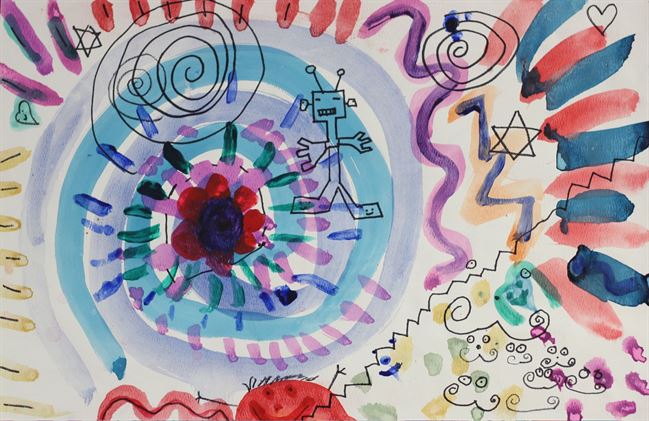 |
Together we examined paintings by the artist Wassily Kandinsky (1866 – 1944). To learn more about the artist we read the book “The Noisy Paint Box: The Colors and Sounds of Kandinsky’s Abstract Art” by Barb Rosenstock and Mary Grandpre. Kandinsky had a condition called synesthesia where his brain processed input through his senses differently than most people. Kandinsky could hear colors and see music, and he painted lines, shapes, and color while listening to music. Like Kandinsky, we listened to music while we painted. Our paintings took three weeks to achieve the layered look you see.
VPAA Standard 2: Apply skills and knowledge to create in the arts. ART.VA.II.1.1 Explore and experiment with materials and processes while creating artwork based on personal routines, activities, or environments. VPAA Standard 3: Analyze, describe, and evaluate works of art. ART.VA.III.1.1 Explore and discuss reasons behind personal artwork. |
Perfect Square Collages |
|
 |
After a reading of “The Perfect Square” by Michael Hall, students responded by creating a collage. They began with two square sheets of paper. In pursuit of developing fine motor skills, they made a change to the smaller square (by tearing, cutting, hole punching, crumpling or crimping) and glued the pieces onto the larger square in an arrangement of their own choosing.
VPAA Standard 1: Apply skills and knowledge to perform in the arts. ART.VA.I.1.2 Demonstrate the responsible use of project materials with environmental awareness. VPAA Standard 2: Apply skills and knowledge to create in the arts. ART.VA.II.1.5 Understand how artists/illustrators use images to tell stories. |
Second & Third Grades
In the middle elementary grades, we begin to incorporate technology into art lessons as students do research to learn more about aspects of art that interest them and to begin creating art. We make many cross-curricular connections to math, social studies, and language arts. We deepen the study of the elements of art, adding value, form, and texture, and we start to emphasize the principles of design in our class discussions and art making.
Landscape Paintings |
|
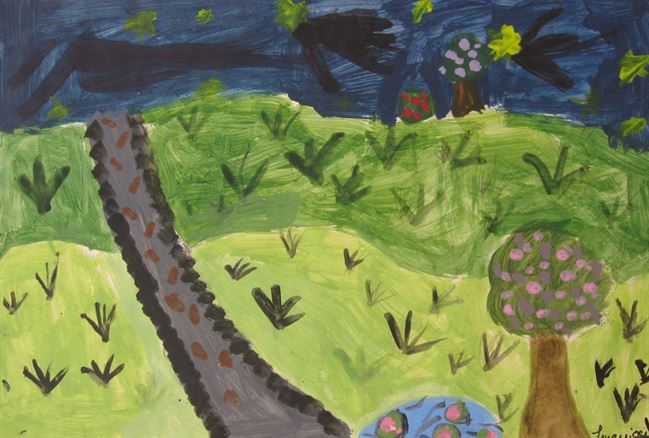 |
Students examined landscape paintings from different time periods and identified features of landscape paintings, including horizon line, foreground, mid-ground, and background. Next students continued their early-elementary exploration into color by mixing the colors they would need for their paintings. Beginning with only red, yellow, blue, white, and black paint, students created their own original landscape paintings.
VPAA Standard 1: Apply skills and knowledge to perform in the arts. ART.VA.I.3.2 Demonstrate control and safe use of a variety of art tools with environmental awareness. VPAA Standard 2: Apply skills and knowledge to create in the arts. ART.VA.II.3.2 Create a composition using the elements of art and principles of design to communicate ideas. |
Coil Pots |
|
 |
The absence of a kiln in our school did not prevent us from creating in clay. Students began by figuring out what the characteristics of pottery are and then read “Dave the Potter: Artist, Poet, Slave,” by Laban Carrick Hill and Bryan Collier. Next, students constructed and painted coil pots, learning how to make coils and how to use those coils for construction and decoration. Although we used air dry clay (as opposed to clay that is fired in a kiln), students still explored the process and learned techniques. We finished the unit by looking at images of pottery from around the world (some pots older than 10,000 years old). Students then used the computers to do additional independent research about a single culture’s historical pottery.
VPAA Standard 1: Apply skills and knowledge to perform in the arts. ART.VA.I.3.2 Demonstrate control and safe use of a variety of art tools with environmental awareness. VPAA Standard 4: Analyze and describe the arts in their historical, social, and cultural contexts. ART.VA.IV.3.3 Recognize how the available materials and processes in a particular time or place can influence the art that is created. ISTE Standard 3: Students critically curate a variety of resources using digital tools to construct knowledge, produce creative artifacts and make meaningful learning experiences for themselves and others. 3d Students build knowledge by actively exploring real-world issues and problems, developing ideas and theories and pursuing answers and solutions. |
Fourth & Fifth Grades
Upper elementary art students continue the work we began in second and third grades, as we incorporate even more technology and individual research into art lessons. The cross-curricular connections continue, and we spend even more time learning about the principles of design. In fourth and fifth grades, students spend more time on design, planning their projects in advance and on metacognition, reflecting on their own design choices after making their art.
Mixed Beast Tunnel Books |
|
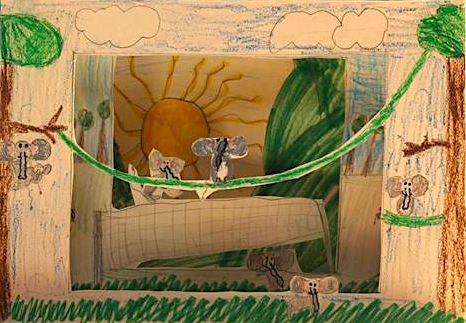 |
To prepare for this project, students did scientific research about animal adaptations in nature, including body coverings (such as spotted fur or white feathers), body parts (such as long legs or hooked beaks), and behaviors. We then read the book “Mixed Beasts” by Kenyon Cox and Wallace Edwards. Using what they learned about body parts and body coverings (those adaptations that they can see), students created their own mixed beast, including a made-up habitat and imaginary hobbies. Finally, students designed and created tunnel books, a 3-D object where the viewer can see depth in a single scene. It can be a challenge to go from 2-D to 3-D but our students did a great job with it.
If you would like to learn more about this unit, see full lesson plans, or get helpful resources, please visit my Blended Learning page where I discuss how I made this unit into a blended learning unit using Canvas. VPAA Standard 1: Apply skills and knowledge to perform in the arts. ART.VA.I.5.2 Use art materials and tools safely and responsibly with environmental awareness. VPAA Standard 2: Apply skills and knowledge to create in the arts. ART.VA.II.3.1 Apply materials and techniques to problem solve in the creation of art. |
Matisse-Inspired Abstract Collages |
|
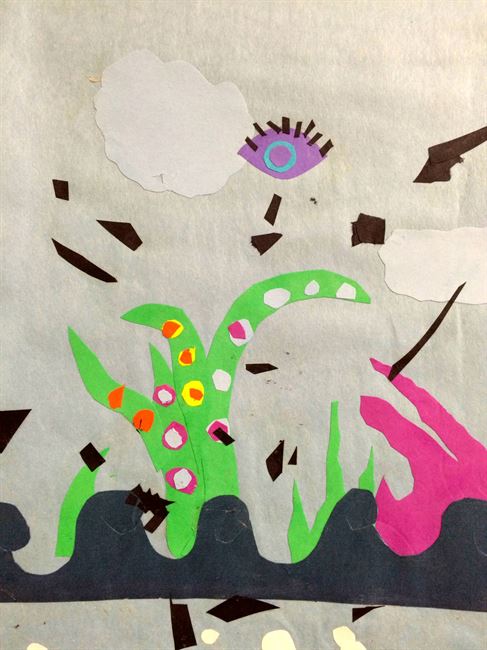 |
Students examined and discussed the abstract collages of Henri Matisse. Although Matisse was a painter for many years, students learned that Matisse was ill in his later years and began making collages. Later he hired assistants to execute his design ideas when he became too weak to handle the materials any longer. Students created their own abstract collages to express themselves using scraps of construction paper.
VPAA Standard 2: Apply skills and knowledge to create in the arts. ART.VA.II.5.4 Select and use subject matter, symbols, and ideas to communicate meaning. VPAA Standard 3: Analyze, describe, and evaluate works of art. ART.VA.III.5.5 Develop a sensitivity and understanding of how personal experiences can influence the development of artwork. |
Middle School
As students create and learn in middle school art classes, they have many opportunities to make personal choices in design, materials, technique, and content. While we still do lessons and activities to reinforce the elements of art and principles of design, they are applied in the creation of art that has deeper personal meaning and content than in prior years.
Digital, Expressive Self-Portraits Inspired by Frida Kahlo |
|
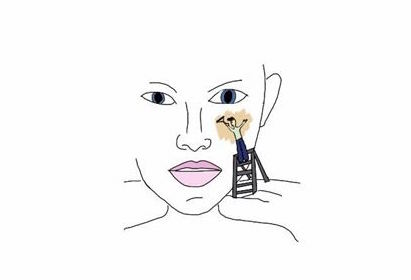 |
Frida Kahlo was a prolific artist known for creating symbolic self-portraits that expressed her pain after polio, a traffic accident, and the loss of a baby. After examining and discussing the content and context of Kahlo’s self-portraits, students in my middle school art elective class created digital self-portraits. The objective was to create a self-portrait that conveyed personal meaning for the artist.
If you would like to read more about the affordances of using digital technology for creating art, read my page Looking at Self-Portraits Through New Lenses. VPAA Standard 1: Apply skills and knowledge to perform in the arts. ART.VA.I.8.3 Select and apply visual characteristics and organizational principles to communicate effectively when designing and solving creative problems. ISTE Standard 6: Students communicate clearly and express themselves creatively for a variety of purposes using the platforms, tools, styles, formats and digital media appropriate to their goals. 6b: Students create original works or responsibly repurpose or remix digital resources into new creations. |
Clay Sculptures Inspired by China’s Song Dynasty |
|
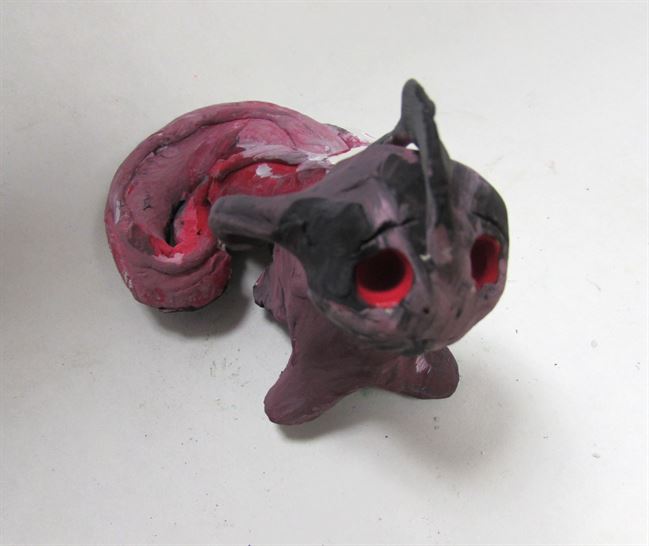 |
In this visual arts unit, I collaborated with the social studies teacher as he taught the students about the Song dynasty (960–1279) of China. Together we studied replicas of original Song dynasty scrolls, as well as other artworks from the time period. Students created animal sculptures that were inspired by the figurative sculptures of the Song dynasty.
VPAA Standard 3: Analyze, describe, and evaluate works of art. ART.VA.III.8.1 Critically observe, describe, and analyze visual characteristics within works of art. VPAA Standard 4: Understand, analyze, and describe the arts in their historical, social, and cultural contexts. ART.VA.IV.8.1 Recognize, describe and analyze, and evaluate how art contributes to and reflects all societies and cultures. |
Philosophy and Other Galleries
To learn more about my educational philosophy and class projects, read my Teaching Philosophy or view my gallery of STEAM student projects.
To see more images of student artwork visit my secondary gallery page.
IMAGES
All images on this page were created by Sarah Van Loo’s art students.
